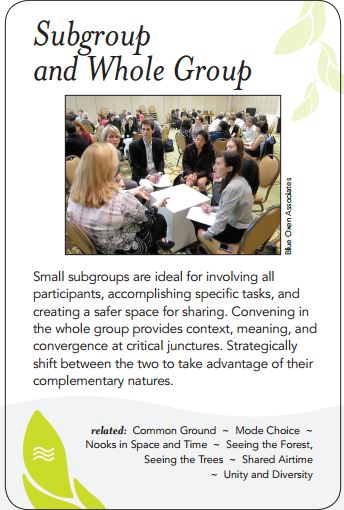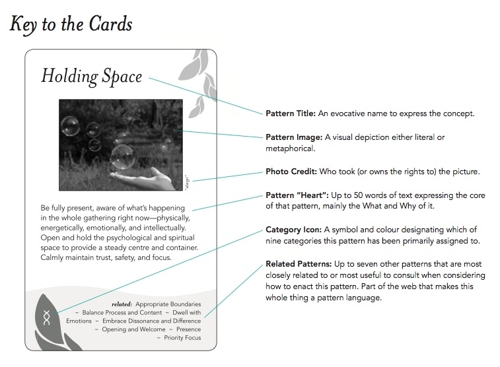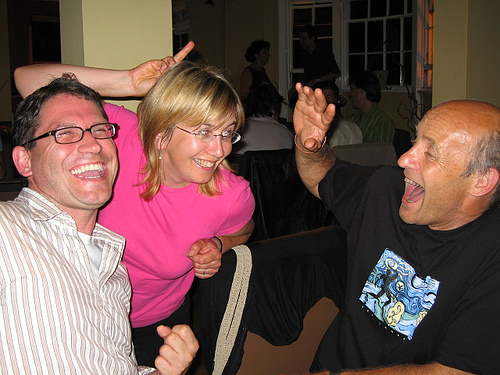[Edit Feb 23: The notes and recording link of this event can be found here: http://faciliteeronline.nl/2012/02/the-spidergram-for-getting-started-with-and-evaluating-communities/comment-page-1/#comment-7704]
Next week I have the great pleasure of facilitating a webinar for some Dutch colleagues of mine. In preparation, they asked me to put together a bit of background to prepare folks for our conversation. I decided to share it on my blog as well, in case any of you, dear readers, had additional insights to add. In other words, walking the “network talk!” [Edit Feb 20 – see the great pre-event comment stream here: http://faciliteeronline.nl/2012/02/digital-habitats-technologies-for-communities-webinar-with-nancy-white/]
The group I’ll be conversing with is a group of 12 people who are involved in learning and change processes in their organizations or with their clients. (This reminds me of Beth Kanter’s Peeragogy.) They are on an 8 month learning journey and have been exploring things like social media (which reminded me of this post on how I use social media – albeit a bit dated), communities of practice, online communities and the like. Now is the time to start weaving across those technological and process areas. So a perfect time for community technology stewardship!
As we prepared for the webinar, some of the random potential bits for discussion included the practice of tech stewardship, the pros and cons of “hopping across technologies,” the tension between thinking about the platform AS the community instead of the people — especially distributed communities, what it means to ‘be together” as a distributed group, more on online facilitation, and how to identify community activities and tools useful in supporting those activities. The webinar will focus mostly on the latter and we’ll use the Activities Spidergram from “Digital Habitats: stewarding technology for communities,” as a learning tool. But to set the stage, I wanted to write a bit about the other topics. Sort of a lead in to the activities conversation. At the bottom of this post, I’ll link to all the artifacts we’ll use next week. And if someone prompts me, I’ll return after the webinar to post an update in the comments! (That means — show me you are interested/care!)
What it means to be together using technology
Groups, communities, pairs, networks are all about people connecting, being together in some way. In the “olden days” this meant being together face to face augmented by these artifacts which carried documentation of our being together called books, and letters that we slowly exchanged with each other via land based transport. Today we spend time with each other online — not just face to face. That may look like reading, replying to or retweeting messages via Twitter, interactions on Facebook, email, blogs, Skype, YouTube, Pinterest or any of hundreds of web based platforms. These platforms convey and hold the artifacts of our interactions. They are the digital traces of being together. But the EXPERIENCE of being together is something we create in our own minds as we navigate these artifacts. Without conversation with others, we may find our individual experiences of “being together” are, in fact, not at all similar. So the first key here is that being together, even technologically mediated, implies that we have to reflect – at least a little bit – about shared or different experiences. Otherwise we may not be “being together.” Sense-making is critical. So if I’m designing or facilitating a social strategy using online tools, I had better darn well design in process to facilitate reflection, sense-making and other similar types of conversations. Yes, conversations, which implies active listening — something you can’t always see or have in pure social media actions.
One of the tough things about all this is how to understand what is working. Is there really connection? We tend to compartmentalize the tech into things like page views. But does that tell us about our quality of being together? Of learning? Of getting things done? Not really. So in thinking about being together in this age, we need new frameworks for assessment. A nice intro to thinking about communities and how to evaluate them comes from a short video from the USAID KM Impact Challenge
Hopping across technologies
If you accept my first proposition that being together requires some sort of sense-making/reflective aspect, lets add on a layer of complication: hopping across different tools and technologies. So not only are we not face to face, but we don’t necessarily interact as a full group, nor on a single communications tool and this may (and usually does) vary over time. Community’s technological configurations change over time. Let’s pick this apart a bit.
1. There is rarely just one tool. From Digital Habitats we framed the idea of configuration this way: “By configuration we mean the overall set of technologies that serve as a substrate for acommunity’s habitat at a given point in time—whether tools belong to a single platform,to multiple platforms, or are free-standing.” For example, we may have a NING site, but we talk to each other on the telephone and no one every identified the telephone as an official community tool. 😉 Look around. Our configurations are rarely as simple as they look. Observe and notice what people are using. Explore if there is a shift from the official platform to others and use that usefully, rather than as a distraction.
2. Togetherness does not imply only full group interactions. Side conversations and “back channel” are an intrinsic and important part of a community’s communication ecosystem. We talk about “capturing” knowledge and having everything in one place, but the reality is that communities have all types of conversations and interactions. Some should stay small and private. Some should be captured and shared. And some will just happen. The key is that people are connected enough so that they DO happen. The interaction has primacy over the container or the captured artifacts … even if this seems counter-intuitive at times.
3. People start where they are technologically comfortable, and move to what serves them over time. Now this may seem like a repetition of #1, but what I’m getting at here is change in technologies is actually part of the life-cycle of many communities rather than an aberration or fatal disruption. (Though, yeah, it can be fatal, but less often than we might expect!) The key lesson here is start where people are “now” and let the needs of the community, its appetite (or not) for experimentation and change drive the platform evolution.
4. A change in technology may intrinsically change the interaction. In our research for “Digital Habitats” we noticed that not only did technology change communities, but communities changed technologies. When members wanted or needed something, they invented new ways of using tools or scrounged for new ones. When the motivation to do something together becomes more urgent and compelling than the platform, it’s affordances or constraints, you know something good is going on. So attention to the community’s domain, community and practice (see that video above!) should be front and center. Technology supports.
Technology stewardship
So if technology changes what it means to be together, if technology choices change over time, it is logical that stewarding that technology becomes part of the life of the community and there is an association between the people who do this and a role — a role we call technology steward. Technology stewards are people who know enough about technology to help scan for, select and implement tools and enough about their community to know what they need and what they want/can tolerate. This is not the traditional IT person or pure geek, but someone who straddles these two domains of knowledge and practice. They are bridgers. (You might enjoy this 6 minute audio from Etienne Wenger, John Smith and I on tech stewardship. ) For example, consider the person who can observe how others use a tool (even if it is different than how they themselves do), notice how it can be valuable to the community and share that practice with others. (An ethnographer!) You have to know the tool, but to observe and understand the practice — that is the magical sweet spot. (For an example, see John Smith’s post on Skype.) Most of us who find ourselves in this role are in it accidentally. I think that is significant!
Community activities and their technological support
So this leads me to the bridge to our webinar next week. Flowing directly out of this idea of technology stewardship is the need for ways to identify important community activities as a precursor to selecting and deploying tools. In the work writing Digital Habitats we identified 9 community orientations which comprise sets of activities that we found happening pretty commonly across different kinds of communities. This slide deck gives a brief overview.
A couple of key things the spidergram exercise has taught me are: 1) observe your community with an open mind rather than through your own preferences. I, for example, love asynchronous conversations, yet in many of my communities, they would not thrive without telephone calls. 2) You can’t prioritize all 9 orientations all at once, but they may shift over time. This impacts community leadership, facilitation, and technology. So as always, this is not primarily about the tech, but about the community. That seems like a “no brainer” yet time and time again we fall into the technology seduction trap! That leads us to community facilitation, but we’ll have to save that for another day!
I’ll be asking the group to read Chapter 6 of Digital Habitats and then begin to fill out a spidergram for a group or community they belong to or work with. I’m also inviting them to post questions here or over at their group blog. But for the rest of you, what sort of advice would you offer for those trying to steward technology for their community? Post in the comments, please!
Resources
- Digital Habitats:stewarding technology for communities book and blog
- Worksheets from Digital Habitats (pdf and copy-able- Google Docs with instructions here.)
- Spidergram worksheets
- More on the Spidergram
- Technology for communities wiki on CPSquare



